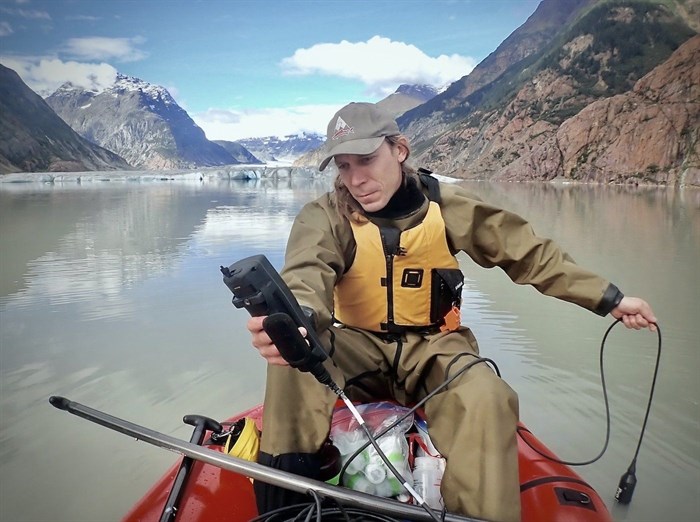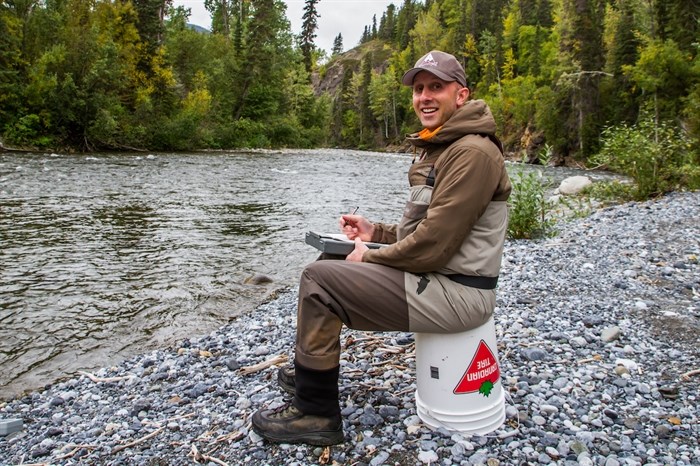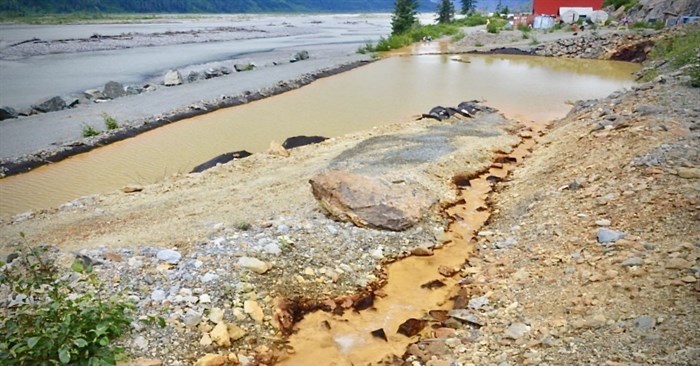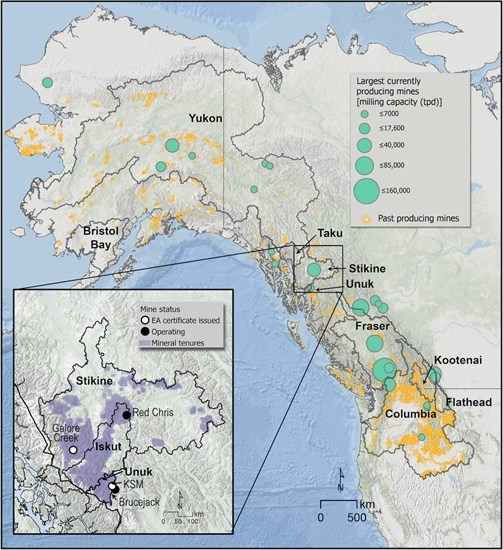
Simon Fraser University research scientist Jonathan Moore takes environmental readings on the Taku River, which is shared between Canada and Alaska.
Image Credit: Photo by Erin Sexton
July 16, 2022 - 9:00 PM
The impact of mining on key salmon watersheds in northwestern Canada and the U.S. is impossible to gauge because of a lack of transparency and access to data.
That was one conclusion of a cross-border study involving a team of experts in salmon ecology, watershed science, mining policy that surveyed the intersection of mining risk with important salmon habitat, ranging from Montana to Alaska as well as B.C. and the Yukon.
The Mount Polley environmental disaster in south central B.C. eight years ago illustrates the damage mining can wreak on salmon and trout habitat — which includes excessive pollution discharge, habitat degradation, and changes to water temperatures and flows that can negatively impact fish, said lead author Christopher Sergeant, a research scientist at the University of Montana.
The failure of a tailings dam at the of Imperial Metals site sent 25 million cubic metres of water and toxic mining slurry coursing through valuable salmon and trout habitat — raising Polley Lake by a metre, and scouring out nine kilometres of prime spawning grounds along Hazeltine Creek before ending up in Quesnel Lake. Mining operations at the site have resumed, but the physical remediation of the creek and the study of the environmental impact continue.
The research paper doesn’t dispute the need for metal or mineral extraction, but illustrates how mining policy and stewardship of salmon habitat could be bolstered by science and transparent risk assessment in the U.S. and Canada, especially in watersheds shared across borders, Sergeant said.
“Obviously, mining is in our future. The need for a lot of those metals is not going away, but we really need to carefully consider [the] tradeoffs,” he said.
“For communities … in these places, salmon have sustained a way of life for literally thousands of years.”
Canadian co-author Jonathan Moore, a researcher at B.C.’s Simon Fraser University, agreed risk assessments and decisions on mining operations need to be based on public information.
A lot of data on potential mines and impacts belongs to industry and isn’t necessarily shared or easily accessible or understood, Moore said.
“Much of the data collected is proprietary … so it might not see the light of day,” he said.
“So one concern is that the full environmental impacts might not be described publicly.”
There is also very little accessible information about the location, oversight and impacts of placer mines in B.C., Sergeant said.
Placer operations, rather than mining in bedrock, use water to separate ore, primarily gold, from stream or river deposits. Operations can vary to a single person panning for gold to mechanical operations that involve machinery and tailings ponds, Sergeant said.

University of Montana research scientist Christopher Sergeant says there is very little public information on the more than 923 placer mines in B.C.
Image Credit: SUBMITTED
There are 923 placer mines in B.C., according to the latest Chief Inspector of Mines report. The province maintains a central mine information website on 73 major operations in B.C., but does not include information on placer mines.
Some potential risks associated with placer mining include toxic substances such as arsenic and mercury finding their way into salmon waterways, the alteration of channels and streams, or sediments washing into waterways and affecting water quality, the study said.
“There's no one-stop-shop to say where all the active [placer] mines are located,” Sergeant said.
“That makes it hard to properly evaluate risks.”
In an email to Canada’s National Observer, B.C.’s Ministry of Energy, Mines and Low Carbon Innovation said placer mines in the province are registered online.
But records including authorizations, inspections and compliance reports on placer operations are only available by request.
There are setbacks to protect wetlands bordering streams and rivers, which vary depending on the type of activity and location of the site, the ministry said.
There are guidelines for hand placer mining while mechanized placer operations must apply for a Mines Act permit and have a plan to protect the environment, cultural resources and to restore land and watercourses, the email said.
The Ministry of Land, Water and Resource Stewardship reviews applications for potential impacts to fish and wildlife habitat before permits are granted, the ministry added.
However, the office did not clarify how it regulates, inspects or ensures compliance at placer mine operations.
Mining exploration in 'golden triangle' heating up

A new study recommends more public information needs to be available on potential environmental risks associated with abandoned mines, such as the Tulsequah Chief Mine, above in 2017, that is leaching into the Taku River watershed.
Image Credit: SUBMITTED
There’s also a new rush of mining exploration taking place in northwestern North America in areas of high mineral value, particularly in the “golden triangle” where the B.C., Yukon and Alaska border one another, Sergeant said.
In B.C. and the Yukon, 41 major mining projects were planned or under construction as of 2020, which collectively represent investments of $28 billion, according to the study.
It found mining tenures, which allow companies the rights to explore ore deposits, are particularly dense in northeastern B.C. in some watersheds shared by both the U.S. and Canada.
Large sections of these watersheds are staked for possible mining, including 59 per cent of the Unuk River Basin, which descends into Alaska to reach the ocean, the study said.
And 54 per cent of the Iskut River — the largest tributary of the cross-border Stikine River — is also covered by tenures that overlap important salmon habitat.

Current and past producing metal and coal mining locations in northwestern North America, with river watersheds outlined. Teal circles represent the largest currently operating mines in the region. The inset illustrates the high density of mineral tenures (purple polygons) in the B.C. extent of the Stikine, Iskut and Unuk rivers.
Image Credit: SUBMITTED
“These river systems still support big, beautiful, globally important salmon populations,” said Moore.
It’s likely authorities are underestimating the cumulative impacts of all stages of the mining process in tandem with other resource activities, such as forestry — not to mention the climate change risks, he added.
Climate change and the cumulative effects from other activities must be taken into account in the project design and outline mitigation measures for potential negative impacts, the mining ministry said.
But environmental mitigation technology slated for future projects needs to be tested at scale in the real world and fully funded before operations begin, the study’s authors recommend.
And major mining proposals with cross-boundary impacts should automatically trigger federal, regional and watershed-scale assessments that include input from affected First Nations or communities even if they are further downstream from the mining site.
“There’s a middle ground here,” Moore said, adding the study isn’t aimed at frustrating mining but improving it to protect a keystone species important to innumerable communities and ecosystems.
“Let's take what we know about how the salmon systems work and then make sure it's getting fed into the governance and stewardship of these systems in a way that makes sense.”
— This story was originally published by Canada's National Observer.
News from © iNFOnews, 2022